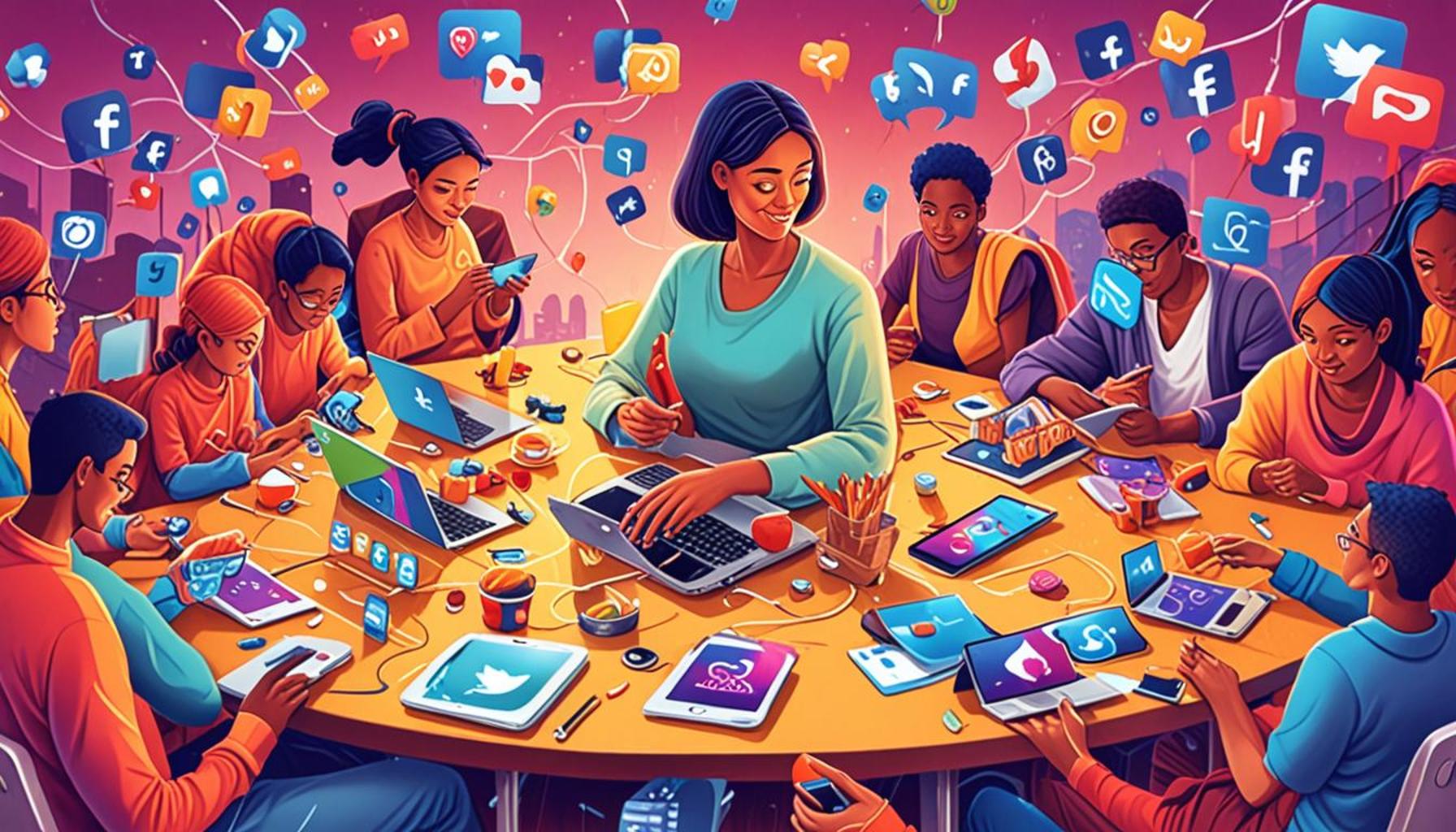The Role of Social Media in Promoting Financial Assistance Resources for Underserved Communities

The Role of Social Media in Enhancing Financial Aid Access
In an era where technology shapes our daily interactions, social media embodies a crucial tool for connection and communication. For underserved communities, this digital realm becomes an integral resource for obtaining financial assistance and support. These communities, often confronted with barriers to traditional banking and finance systems, find social media platforms providing unique opportunities to bridge those gaps.
First and foremost, the ability of social media to facilitate immediate dissemination of information cannot be overstated. Grants, loans, and assistance programs can be launched and shared within minutes across various platforms like Instagram, Facebook, and Twitter. For example, in the wake of natural disasters such as Hurricane Katrina or the COVID-19 pandemic, local authorities and organizations have utilized social media to communicate available resources swiftly, ensuring that those in need are well-informed of opportunities for assistance.
Moreover, community engagement is significantly enhanced through such platforms, as they provide a space for discussions and the sharing of personal experiences. This personalization creates a supportive environment where individuals feel less isolated in their financial struggles. Various community groups and online forums on sites like Facebook have empowered users to discuss their relationships with money, share financial tips, or even troubleshoot their experiences with potential lenders.
Additionally, awareness campaigns led by nonprofits and organizations have gained traction by utilizing platforms like Twitter and Snapchat. For instance, initiatives aimed at promoting financial literacy often leverage hashtags to unite discussions around changing policies or alerting the public about new grants. In the U.S., organizations like the National Endowment for Financial Education have effectively harnessed social media to disseminate educational content, helping underserved populations become more financially savvy.
Statistics reveal the overwhelming impact of social media in this arena. Approximately 69% of U.S. adults engage with social media, making it a vital channel for outreach and support. Moreover, within this group, younger individuals, particularly Millennials and Gen Z, represent the forefront of social media users and thus become essential advocates for financial resources and literacy.
Understanding how social media can enhance resource accessibility is critical not only for individuals seeking aid but also for organizations striving to elevate financial literacy and reduce disparities. Exploring this topic further highlights the multifaceted role that social media plays in empowering underserved communities, encouraging them to explore the financial options available at their fingertips.
SEE ALSO: Click here to read another article
Empowering Connections Through Digital Platforms
The importance of social media in promoting financial assistance resources for underserved communities cannot be overstated. These platforms serve not only as a means of communication but also as powerful vehicles for fostering relationships between aid providers and communities in need. The effectiveness of these connections hinges on several key aspects, such as outreach, accessibility, and collaboration.
One of the most significant advantages of social media is its ability to reach a wide audience. Organizations can now conduct outreach with a few clicks, sharing essential financial resources ranging from grants to emergency funds. For instance, during the COVID-19 pandemic, the use of social media skyrocketed as organizations shared crucial information about the Payroll Protection Program, the Economic Injury Disaster Loan, and other assistance options. The rapid spread of information not only educated the public but also motivated individuals to take action quickly.
Access to Information
Social media platforms also enhance access to information regarding financial educational resources. Traditional media often lacks the immediacy and engagement that social media provides. Here are a few ways in which social media facilitates access and understanding:
- Infographics and Videos: Many organizations produce easily digestible content such as infographics and video tutorials that explain intricate financial concepts or eligibility requirements in a straightforward manner.
- Live Q&A Sessions: Platforms like Facebook Live and Instagram allow organizations to host real-time Q&A sessions where users can ask specific questions related to financial assistance resources.
- Community Groups: Groups dedicated to financial assistance can provide a sense of belonging and allow individuals to seek advice from peers who have had similar experiences.
Furthermore, social media allows for the customization of content targeted towards specific demographics within underserved communities. Many organizations utilize analytics tools to gain insights into their audience’s interests, preferences, and challenges. For example, nonprofits can tailor financial advice specifically for minorities, single-parent households, or low-income families, thus addressing the unique financial hurdles faced by these groups. This personalized approach helps cultivate a deeper understanding of financial matters and enhances participation in available programs.
Organizations can also harness the power of social media influencers to elevate their messaging. These influencers often have established trust within their communities and possess the ability to share valuable financial resources effectively. Collaborations can add a layer of authenticity to financial discussions, encouraging individuals to engage with materials and seek assistance without feeling stigmatized.
In a world increasingly reliant on digital communication, the role of social media in promoting access to financial assistance can’t be overlooked. The potential to democratize information and provide a platform for underserved communities to learn, share, and obtain assistance is paramount. By leveraging these tools, both organizations and individuals can work together to build a financially literate society that bridles equity and opportunity.
| Advantage | Description |
|---|---|
| Increased Accessibility | Social media platforms provide a virtual space where individuals can easily access financial assistance resources, breaking down geographical barriers. |
| Community Engagement | Social media fosters a sense of community, allowing users to share experiences and advice about financial assistance, thus enhancing collective knowledge. |
| Real-Time Updates | Users can receive immediate updates on new funding opportunities or changes in financial assistance programs, ensuring they stay informed. |
Social media plays a pivotal role in promoting financial assistance resources for underserved communities. By utilizing platforms like Facebook, Twitter, and Instagram, non-profits and government agencies can directly reach individuals who may otherwise be unaware of available support. Furthermore, social media influences campaign outreach, allowing organizations to tailor messages to specific audiences, ensuring greater engagement and accessibility. The combination of these factors results in a powerful tool for dissemination of critical financial information. The effectiveness of digital engagement is notable — surveys indicate that many underserved individuals feel more comfortable seeking help through social media channels where they can maintain their privacy compared to traditional routes. As these platforms continue to evolve, they present exciting opportunities for increasing financial literacy and resource-sharing in financial assistance programs. Engaging content and targeted campaigns can help bridge the gap for those lacking access, illuminating the path towards better financial futures. The landscape is changing, and social media stands at the forefront of fostering inclusivity and awareness.
CHECK OUT: Click here to explore more
Building Trust in Financial Messaging
Another pivotal function of social media in the context of financial assistance resources is its role in building trust among underserved communities. Trust is a critical component when it comes to financial decisions, especially for individuals who may have had negative experiences with financial institutions. Social media helps to bridge this gap by fostering an ongoing dialogue between communities and the organizations designed to support them.
One key element in establishing this trust is the use of storytelling. By sharing success stories, financial institutions and nonprofit organizations can humanize their services, demonstrating the tangible benefits of financial assistance. For example, community organizations frequently share testimonials from individuals who have successfully accessed aid, illustrating their journeys from financial uncertainty to stability. These personal narratives not only resonate emotionally but also inspire others to take action.
The integration of peer-to-peer networking within social media platforms further enhances trust-building. In online groups or forums, community members can provide firsthand accounts of their experiences with various financial programs. This shared knowledge helps to dispel misinformation and manage expectations regarding services. Furthermore, when community members see their peers sharing positive experiences, they are more likely to engage with the resources being discussed.
The Role of Social Media Campaigns
Effective social media campaigns can amplify the reach and impact of financial assistance messages. By employing targeted advertising, organizations can ensure that financial resources are reaching those who need them most. For instance, by analyzing demographic data, campaigns can be directed toward specific neighborhoods or populations with higher needs, increasing the likelihood of engagement with financial support programs.
During times of crisis, such as natural disasters or economic downturns, social media campaigns can rally community support and ensure that resources are distributed effectively. A notable example is the response to Hurricane Harvey, where social media played a crucial role in connecting those affected with financial aid resources. Community-driven campaigns highlighted local resources, fundraising efforts, and volunteer opportunities that collectively mobilized significant support.
Moreover, social media provides a platform for stimulating community engagement through challenges and initiatives closely tied to financial literacy. Initiatives that encourage individuals to share their financial goals or pledge to save money can create a sense of accountability and shared mission. This can also breed a culture of dialogue about fiscal responsibility, helping to normalize discussions around budgeting, saving, and investing within underserved communities.
Lastly, the power of social media analytics cannot be overlooked. Organizations can gain valuable insights into the effectiveness of their strategies by tracking engagement metrics such as shares, likes, and comments. This feedback loop allows for the continual refinement of outreach methods and messaging to better serve the community’s needs. As organizations adapt their strategies based on real-time data, they can effectively respond to evolving challenges and ensure that financial assistance resources remain accessible and relevant.
In essence, social media not only empowers underserved communities by disseminating crucial information on financial assistance but also fosters a supportive ecosystem where trust, collaboration, and community engagement flourish. By navigating this digital landscape effectively, organizations can make significant strides toward promoting financial resources and creating lasting change within these communities.
ADDITIONAL INSIGHTS: Expand your understanding here
Conclusion: Harnessing the Power of Social Media for Financial Empowerment
As we have explored, social media has emerged as a transformative tool in connecting underserved communities with essential financial assistance resources. The platform goes beyond mere information dissemination; it actively fosters engagement, builds trust, and encourages community collaboration. By harnessing the power of storytelling, social media allows organizations to share authentic experiences that resonate profoundly with individuals who may feel disconnected from traditional financial institutions.
The integration of peer-to-peer networking further magnifies this impact, as community members can exchange valuable insights and support one another on their financial journeys. Through targeted social media campaigns, vital resources can be effectively directed toward those most in need, enhancing equity in access to financial aid, particularly during crises like natural disasters or economic downturns.
Moreover, social media’s role in fostering a culture of dialogue around financial literacy can tremendously benefit underserved populations. By encouraging discussions about budgeting, saving, and responsible spending, these platforms can redefine the narrative around financial health and stability.
In conclusion, it is clear that social media holds immense potential to not only promote financial assistance but also to empower individuals within underserved communities. As organizations continue to leverage analytics and feedback to refine their messaging, the future looks promising for creating more informed and resilient communities. By adopting innovative social media strategies, we can pave the way toward enduring financial empowerment and a more equitable society.


